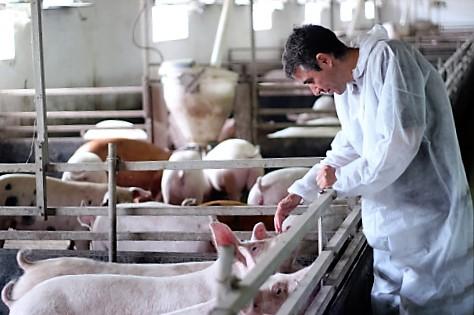With federal efforts to reduce the amount of antibiotics used to raise the nation's livestock and poultry lagging, state legislatures, city governments, and institutional food purchasers across the country are picking up the slack, a report today from the Consumer Federation of America (CFA) suggests.
Among the highlighted efforts are laws passed in California and Maryland that prohibit food producers from regularly using medically important antibiotics for disease prevention in their herds and flocks. These laws, set to take effect in 2018, go a step beyond the efforts of the Food and Drug Administration (FDA), which has implemented reforms to end the use of medically important antibiotics for growth promotion in food-producing animals but still allows for their use in disease prevention.
While state laws might represent the best path for large-scale reform of antibiotic use in food-producing animals, municipal governments, school districts, universities, and hospitals are making their voices heard by adopting policies that require the purchase of meat raised with fewer or no antibiotics. These lower-profile actions, the authors of the report say, are important efforts in the fight to preserve the efficacy of antibiotics.
"Given the inadequacies in existing federal policy, and no sign that major reforms are forthcoming, state and local actions to reduce animal antibiotic use is critical," the authors write. "Fortunately, advocates across the country are finding ways around the federal government to influence how antibiotics are used in livestock production."
Stricter state laws
According to the most recent estimates, somewhere between 70% and 80% of medically important antibiotics sold in the United States are for use in food-producing animals. Because of the links between the overuse of antibiotics in animal agriculture and the emergence of antibiotic-resistant pathogens in both veterinary and human health, most public health and infectious disease experts agree that efforts to slow the spread of antibiotic resistance must include policies to reduce this amount.
But the FDA has been "slow to act," the report argues, and its most recent reform efforts to promote judicious use of antibiotics by livestock and poultry producers, while a step in the right direction, may be too modest to significantly reduce antibiotic use on US farms. In particular, the report criticizes the FDA's current policy—spelled out in Guidance #209 and Guidance #213—for reliance on voluntary compliance from farmers and pharmaceutical companies and for allowing the routine use of medically important antibiotics for disease prevention.
The laws passed in California and Maryland take a narrower position on judicious use. California's SB 27 allows for use of medically important antibiotics in disease prevention, but only in extraordinary circumstances. Maryland's Senate Bill 422 contains similar language.
In addition, California's law calls for the California Department of Food and Agriculture to collect data on the sales and uses of medically important antibiotics from the state's livestock producers. Other laws regarding the use of antibiotics in animal agriculture are being considered in Oregon, Pennsylvania, North Carolina, and New York.
This type of state legislation "may represent the most promising means of tackling antibiotic resistance in the absence of effective federal action," the authors write.
Among the municipal efforts highlighted in the report is San Francisco's Ordinance 170763, a measure that requires the city's large grocery stores to submit reports to city officials on the use of antibiotics in the meat and poultry they sell. The reports will include the average number of days of antibiotic use per animal, the percentage of animals treated with antibiotics, and the different purposes for which antibiotics are used, and are to be posted on the city's website for public view. The ordinance, which has been criticized by the grocery and meat processing industries, was passed by the city's Board of Supervisors on Oct 3.
Influencing practices through procurement
Another effective, and perhaps less controversial, tool for encouraging food producers to use antibiotics less frequently is procurement—the process through which institutions find and acquire goods and services. As the CFA report explains, institutions such as city departments, school districts, universities, and hospitals in recent years have enacted procurement policies that favor buying meat and poultry raised without antibiotics or with minimal use of antibiotics.
"By purchasing from producers who do not use antibiotics, or are certified as using them responsibly, cities, schools, hospitals and other public institutions are influencing industry to shift production practices in a way that ensures antibiotics are used less frequently," the authors write.
One of the most high-profile procurement programs is the Good Food Purchasing Program, which was adopted by the City of Los Angeles in 2012 and has since been adopted by other cities. Under this policy, which bases food purchasing decisions on five core values (developing local economies, maintaining nutrition, supporting a valued workforce, promoting environmental sustainability, and protecting animal health), city departments are encouraged to buy meat and poultry raised without antibiotics.
Schools across the country, meanwhile, are doing their part with the help of organizations like School Food FOCUS and the Urban School Food Alliance, which connect school districts with food producers, processors, manufacturers, and distributors. These organizations help leverage the purchasing power of schools to create a demand for meat and poultry raised on fewer antibiotics.
One of the by-products of this effort, created by School Food FOCUS and the Pew Charitable Trusts in 2015, is the Certified Responsible Antibiotic Use (CRAU) standard, which ensures that chicken purchased by schools and other institutions has been raised with minimal use of antibiotics (only after the animals have been diagnosed as having, or exposed to, a bacterial infection). The US Department of Agriculture verifies compliance with the standard through audits of suppliers.
Among the universities that have adopted a "no antibiotics ever" policy in the meat they buy and serve are Yale University, the University of Massachusetts, and the University of Washington.
Medical facilities are also banding together to increase their ability to influence the production of meat and poultry with fewer antibiotics. This effort has been aided by the organizations Healthcare Without Harm and Practice Greenhealth, which are encouraging participating hospitals to buy less meat overall and increase the purchase of meat raised without routine antibiotics by 5% each year. According to the CFA report, more than 1,000 hospitals nationwide have committed to this effort.
Thomas Gremillion, co-author of the report and director of CFA's Food Policy Institute, said that these efforts are important because the nature of the problem requires action at all levels. But ultimately, he says, stronger policies at the federal level will be needed.
"Even with the progress being made at the state and local level, a stronger federal role is critical because antibiotic resistance is already killing tens of thousands of people in the United States each year," he told CIDRAP News.
See also:
Oct 5 CFA report "Going Local: Initiatives to Reduce Antibiotics in the Food Supply"
Oct 3 San Francisco Examiner story on local ordinance























